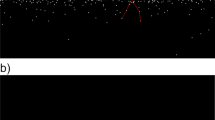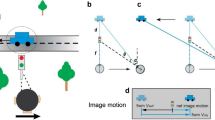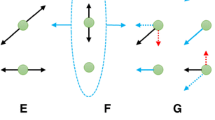Abstract
In this paper we propose a new model,Frenet-Serret motion, for the motion of an observer in a stationary environment. This model relates the motion parameters of the observer to the curvature and torsion of the path along which the observer moves. Screw-motion equations for Frenet-Serret motion are derived and employed for geometrical analysis of the motion. Normal flow is used to derive constraints on the rotational and translational velocity of the observer and to compute egomotion by intersecting these constraints in the manner proposed in (Durić and Aloimonos 1991) The accuracy of egomotion estimation is analyzed for different combinations of observer motion and feature distance. We explain the advantages of controlling feature distance to analyze egomotion and derive the constraints on depth which make either rotation or translation dominant in the perceived normal flow field. The results of experiments on real image sequences are presented.
Similar content being viewed by others
Explore related subjects
Discover the latest articles, news and stories from top researchers in related subjects.References
Albus, J.S. 1991. Outline for a theory of intelligence.IEEE Transactions On Systems, Man, and Cybernetics, 21:473–509.
Aloimonos, J. and Brown, C.M. 1984. The relationship between optical flow and surface orientation. InProc. International Conference on Pattern Recognition, pp. 542–545.
Bottema, O. and Roth, B. 1979.Theoretical Kinematics. North-Holland, Amsterdam.
Bruss, A. and Horn, B.K.P. 1983. Passive navigation.Computer Vision, Graphics, Image Processing, 21:3–20.
Dreschler, L. and Nagel, H.H. 1982. Volumetric model and 3-D trajectory of a moving car derived from monocular TV frame sequences of a street scene.Computer Graphics Image Processing, 20: 199–228.
Durić, Z. and Aloimonos, Y. 1991. Passive navigation: An active and purposive solution. Computer Vision Labaratory, Center for Automation Research, University of Maryland, College Park, Technical Report CAR-TR-482.
Horn, B.K.P. and Weldon Jr., E.J. 1988. Direct methods for recovering motion.International Journal of Computer Vision, 2:51–76.
Horn, B.K.P. and Schunck, B.G. 1981. Determining optical flow.Artificial Intelligence, 17:189–203.
Ikeuchi, K. 1984. Shape from regular patterns.Artificial Intelligence, 22:49–75.
Kreyszig, E. 1959.Differential Geometry. University of Toronto Press, Toronto, Canada.
Longuet-Higgins, H.C. and Prazdny, K. 1980. The interpretation of a moving retinal image.Proceedings Royal Society London B, 208:385–397.
Negahdaripour, S. and Horn, B.K.P. 1987. A direct method for locating the focus of expansion. MIT Artificial Intelligence Laboratory, Massachusetts Institute of Technology, Cambridge, MA, AI Memo 939.
Raviv, D. and Herman, M. 1991. A new approach to vision and control for road following. InProc. IEEE Workshop on Visual Motion, pp. 217–225.
Spetsakis, M.E. and Aloimonos, J. 1990. Structure from motion using line correspondences.International Journal of Computer Vision, 4:171–183.
Tomasi, C. and Kanade, T. 1991. Factoring image sequences into shape and motion. InProc. IEEE Workshop on Visual Motion, pp. 21–28.
Tsai, R.Y. and Huang, T.S. 1984. Uniqueness and estimation of three dimensional motion parameters of rigid objects with curved surfaces.IEEE Transactions on Pattern Analysis and Machine Intelligence, 6:13–27.
Verri, A. and Poggio, T. 1987. Against quantitative optical flow. InProc. International Conference on Computer Vision, pp. 171–180.
Author information
Authors and Affiliations
Additional information
The support of the Air Force Office of Scientific Research under Grant F49620-93-1-0039 is gratefully acknowledged.
Rights and permissions
About this article
Cite this article
Durić, Z., Rosenfeld, A. & Davis, L.S. Egomotion analysis based on the Frenet-Serret motion model. Int J Comput Vision 15, 105–122 (1995). https://doi.org/10.1007/BF01450851
Issue Date:
DOI: https://doi.org/10.1007/BF01450851




